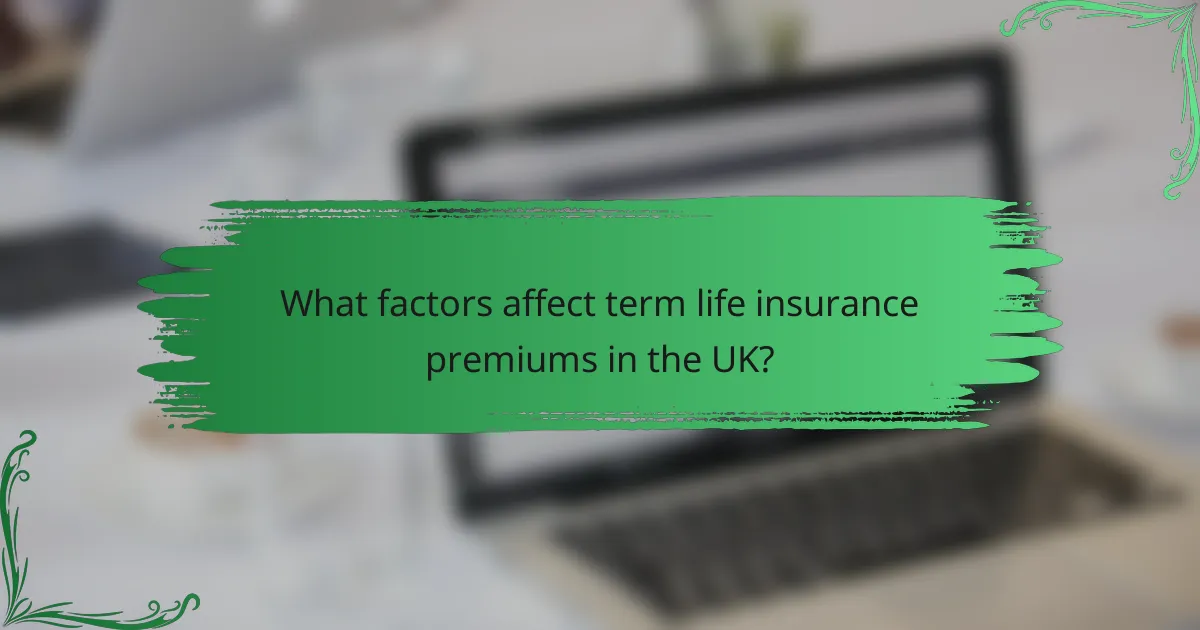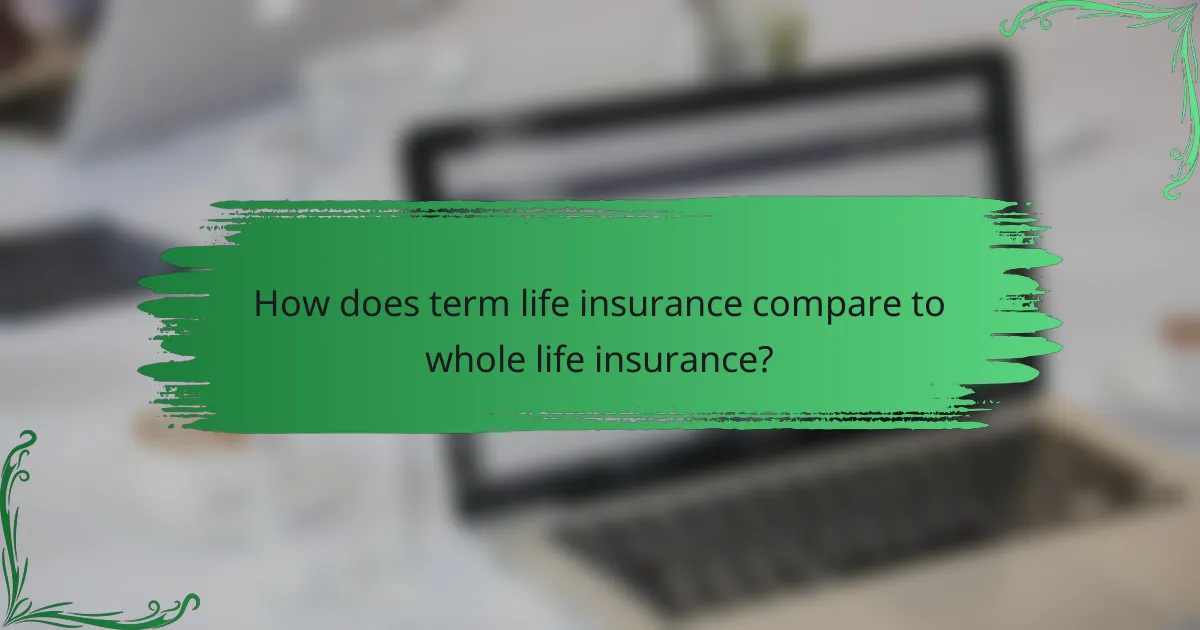Term life insurance is a vital tool for ensuring financial security and peace of mind for families in the event of an unexpected loss. By providing a guaranteed payout to beneficiaries, it helps cover essential expenses and protects loved ones from financial hardship during difficult times. Choosing the right policy involves careful evaluation of your family’s needs and available options to ensure comprehensive coverage.

How does term life insurance provide financial security in the UK?
Term life insurance offers financial security in the UK by ensuring that beneficiaries receive a guaranteed payout if the policyholder passes away during the policy term. This financial support can help cover living expenses, debts, and future needs, providing peace of mind for families.
Guaranteed payout for beneficiaries
A key feature of term life insurance is the guaranteed payout, which is typically a lump sum paid to the policyholder’s beneficiaries upon their death. This payout can be crucial for families, helping them maintain their standard of living and cover immediate expenses such as funeral costs and outstanding debts.
In the UK, the payout amount can vary widely based on the policy chosen, often ranging from tens of thousands to several million pounds. It’s essential to select a coverage amount that adequately reflects the family’s financial needs and obligations.
Affordable premiums for families
Term life insurance is generally more affordable than whole life insurance, making it accessible for many families. Premiums are often lower because the coverage is temporary, typically lasting between 10 to 30 years, and does not build cash value.
Families can find policies starting from as little as £5 to £10 per month, depending on factors such as age, health, and the amount of coverage desired. This affordability allows families to secure financial protection without straining their budgets.
Coverage for specific terms
Term life insurance provides coverage for specific periods, allowing policyholders to align their insurance needs with significant life events. Common terms include 10, 20, or 30 years, which can coincide with raising children or paying off a mortgage.
Choosing a term that matches the family’s financial responsibilities is crucial. For example, a 20-year term may be ideal for parents with young children, ensuring that their dependents are protected until they reach financial independence.

What are the key benefits of term life insurance?
Term life insurance offers essential benefits such as financial security, peace of mind, and protection for your family in case of unforeseen events. It provides a straightforward way to ensure that your loved ones are financially supported during challenging times.
Peace of mind for policyholders
Having term life insurance allows policyholders to feel secure knowing that their family will be financially protected in the event of their death. This peace of mind can reduce stress and anxiety about the future, enabling individuals to focus on their daily lives and responsibilities.
Many people find comfort in knowing that their loved ones will have the necessary funds to cover living expenses, debts, or educational costs. This assurance can be particularly valuable for parents or caregivers who are the primary earners in their households.
Protection against unexpected events
Term life insurance serves as a safety net against unexpected events such as accidents or sudden illnesses. By providing a death benefit, it ensures that your family is not left in financial distress should the unthinkable occur.
For instance, if the primary breadwinner passes away unexpectedly, the insurance payout can help cover mortgage payments, childcare expenses, and other essential costs, allowing the family to maintain their standard of living during a difficult time.
Flexible coverage options
Term life insurance offers various coverage options that can be tailored to meet individual needs. Policies typically range from 10 to 30 years, allowing policyholders to choose a term that aligns with their financial goals and family situation.
Additionally, many insurers provide options to convert term policies to permanent life insurance without undergoing further medical evaluations. This flexibility can be beneficial as life circumstances change, ensuring continued protection as needs evolve.

How to choose the right term life insurance policy?
Choosing the right term life insurance policy involves evaluating your financial needs, comparing policy features, and assessing insurance providers. This process ensures you select a policy that offers adequate coverage for your family’s future financial security.
Assessing personal financial needs
Start by determining how much coverage your family would need in the event of your passing. Consider factors such as outstanding debts, living expenses, and future financial goals like education costs for children. A common rule of thumb is to aim for coverage that is 10-15 times your annual income.
Additionally, evaluate your current financial situation, including savings and investments, to understand how much life insurance you may require. This assessment will help you avoid over-insuring or under-insuring your loved ones.
Comparing policy features
When comparing term life insurance policies, focus on key features such as the length of the term, premium costs, and conversion options. Most policies offer terms ranging from 10 to 30 years, so choose one that aligns with your financial obligations.
Look for policies that provide flexible conversion options, allowing you to switch to a permanent policy without undergoing additional medical underwriting. This can be beneficial if your health changes during the term.
Evaluating insurance providers
Research various insurance providers to find one with a solid reputation and strong financial stability. Check ratings from independent agencies like A.M. Best or Standard & Poor’s, which assess the insurer’s ability to pay claims.
Read customer reviews and testimonials to gauge the quality of customer service and claims processing. A provider with a responsive claims department can significantly impact your experience during a difficult time.

What factors affect term life insurance premiums in the UK?
Several key factors influence term life insurance premiums in the UK, including the applicant’s age, health status, policy term length, and coverage amount. Understanding these elements can help individuals make informed decisions about their insurance needs and costs.
Age and health status
Age is a significant factor in determining term life insurance premiums, as younger applicants typically pay lower rates. Insurers assess health status through medical history and lifestyle choices, such as smoking or exercise habits, which can further impact costs.
For example, a 30-year-old non-smoker may pay substantially less than a 50-year-old with health issues. It’s essential to disclose accurate health information to avoid complications during the claims process.
Policy term length
The length of the policy term directly affects premiums; longer terms generally result in higher costs. This is because the insurer takes on more risk over an extended period, increasing the likelihood of a payout.
Common policy terms range from 10 to 30 years. Choosing a term that aligns with your financial responsibilities, such as mortgage payments or children’s education, can help balance premium costs with coverage needs.
Coverage amount
The coverage amount, or sum assured, is another critical factor influencing premiums. Higher coverage amounts lead to increased premiums, as the insurer’s potential payout rises.
When selecting a coverage amount, consider your family’s financial needs, including debts, living expenses, and future obligations. A common guideline is to aim for coverage that is 10 to 15 times your annual income to ensure adequate protection for your loved ones.

What are common misconceptions about term life insurance?
Many people hold misconceptions about term life insurance that can hinder their understanding and decision-making. These misunderstandings often revolve around who benefits, the cost, and the necessity of coverage for younger families.
It only benefits the insured
A common belief is that term life insurance only provides benefits to the insured individual. In reality, the primary purpose of this insurance is to offer financial protection to the policyholder’s beneficiaries in the event of their death. This means that loved ones can receive a payout that helps cover living expenses, debts, or future needs.
For example, if a parent passes away unexpectedly, the term life insurance can ensure that their children’s education and daily living costs are taken care of, providing peace of mind during a difficult time.
Term life insurance is too expensive
Many people assume that term life insurance is prohibitively expensive, but this is often not the case. In fact, term life policies can be quite affordable, especially for younger individuals in good health. Premiums can start as low as a few dollars per month, depending on age, health, and coverage amount.
It’s essential to compare quotes from different insurers to find a policy that fits your budget. Many online tools can help you easily assess your options and find competitive rates.
Coverage is unnecessary for young families
Some young families believe that term life insurance is not necessary because they are in good health and have many years ahead of them. However, this perspective can be shortsighted. Young families often have significant financial responsibilities, such as mortgages or childcare costs, which can become burdensome if a primary earner passes away.
Having term life insurance can provide essential financial security, ensuring that dependents are protected and can maintain their quality of life. It is often more cost-effective to secure a policy while young and healthy, as premiums typically increase with age and health issues.

How does term life insurance compare to whole life insurance?
Term life insurance provides coverage for a specific period, typically ranging from 10 to 30 years, while whole life insurance offers lifelong protection with a cash value component. The key difference lies in cost, flexibility, and the purpose of the policy, making it essential to evaluate your financial goals when choosing between the two.
Cost differences
Term life insurance is generally more affordable than whole life insurance. Premiums for term policies can be significantly lower, often costing a fraction of what whole life premiums would be for the same coverage amount. For example, a healthy individual in their 30s might pay around $20 to $30 per month for a $500,000 term policy, whereas a whole life policy for the same amount could exceed $300 monthly.
When considering cost, it’s crucial to factor in the long-term implications. Term life insurance does not accumulate cash value, meaning you pay only for the death benefit. In contrast, whole life policies build cash value over time, which can be accessed or borrowed against, but at a higher initial cost. Weighing the immediate affordability of term against the long-term investment of whole life is vital for making an informed decision.



